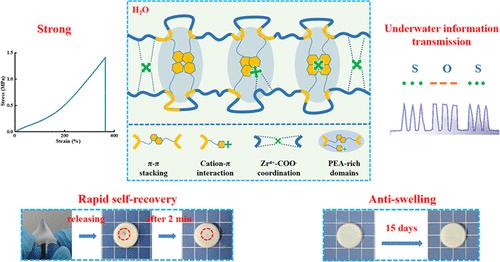用于水下信息传输的高强度、快速自恢复仿生抗膨胀水凝胶传感器
IF 8.2
2区 材料科学
Q1 MATERIALS SCIENCE, MULTIDISCIPLINARY
引用次数: 0
摘要
基于水凝胶的传感器通常在水环境中表现出明显的膨胀行为,这可能严重损害机械完整性并扭曲传感信号,从而极大地限制了它们的广泛应用。从生物组织的多层非均相结构中汲取灵感,通过水诱导相分离和配位交联策略制备了一种强度高、自恢复快、溶胀率低的抗溶胀水凝胶传感器。通过将“刚性”四齿羧基- zr4 +配位键和具有π -π堆叠和阳离子-π相互作用的“软”疏水富单元区整合到水凝胶中,形成了致密的非均质结构。这种独特的结构设计促进了水凝胶网络内的交联在外部载荷下从“软”到“硬”的逐步断裂,有效地耗散能量,从而赋予水凝胶特殊的机械特性,其强度为1.42 MPa,并在3分钟内完全自我恢复。“刚性”和“软”动态相互作用通过增强交联密度,协同增强了水凝胶网络的弹性收缩力,从而使水凝胶在水中(膨胀率仅为- 2.49%)、不同pH(1-9)溶液和海水中具有突出的抗膨胀能力。此外,由于动态离子(Cl -和Zr4+)的协同贡献,水凝胶表现出良好的应变敏感性(测量因子高达2.45)和频率响应。因此,水凝胶被用来组装具有使用莫尔斯电码传输信息能力的水下传感器。这种受生物启发的设计方法在水凝胶中实现了机械、抗膨胀和传感性能的理想集成,从而为水下传感器技术的进步提供了创新的见解。本文章由计算机程序翻译,如有差异,请以英文原文为准。

Bioinspired Antiswelling Hydrogel Sensors with High Strength and Rapid Self-Recovery for Underwater Information Transmission
Hydrogel-based sensors typically demonstrate conspicuous swelling behavior in aqueous environments, which can severely compromise the mechanical integrity and distort sensing signals, thereby considerably constraining their widespread applicability. Drawing inspiration from the multilevel heterogeneous structures in biological tissues, an antiswelling hydrogel sensor endowed with high strength, rapid self-recovery, and low swelling ratio was fabricated through a water-induced phase separation and coordination cross-linking strategy. A dense heterogeneous architecture was developed by the integration of “rigid” quadridentate carboxyl–Zr4+ coordination bonds and “soft” hydrophobic unit-rich regions featuring π–π stacking and cation–π interactions into the hydrogels. This unique structural design facilitated the progressive breaking of cross-links within the hydrogel network from “soft” to “rigid” under external loads, effectively dissipating energy and thereby imparting the hydrogels with exceptional mechanical characteristics, evidenced by a strength of 1.42 MPa, and complete self-recovery within 3 min. Simultaneously, the “rigid” and “soft” dynamic interactions synergistically conferred augmented elastic retractive forces on the hydrogel network by enhancing cross-linking density, thereby providing the hydrogels with prominent antiswelling capabilities in water (with a swelling ratio of only −2.49%), in solutions with diverse pH (1–9), and in seawater. Moreover, the hydrogels manifested favorable strain-sensitivity (gauge factor up to 2.45) and frequency response by virtue of the collaborative contribution of dynamic ions (Cl– and Zr4+). Consequently, the hydrogels were utilized to assemble underwater sensors with the capacity to transmit information using Morse code. This bioinspired design methodology achieved the desired integration of the mechanical, swelling-resistant, and sensing performance within the hydrogels, thereby contributing innovative insights toward the advancement of underwater sensor technology.
求助全文
通过发布文献求助,成功后即可免费获取论文全文。
去求助
来源期刊

ACS Applied Materials & Interfaces
工程技术-材料科学:综合
CiteScore
16.00
自引率
6.30%
发文量
4978
审稿时长
1.8 months
期刊介绍:
ACS Applied Materials & Interfaces is a leading interdisciplinary journal that brings together chemists, engineers, physicists, and biologists to explore the development and utilization of newly-discovered materials and interfacial processes for specific applications. Our journal has experienced remarkable growth since its establishment in 2009, both in terms of the number of articles published and the impact of the research showcased. We are proud to foster a truly global community, with the majority of published articles originating from outside the United States, reflecting the rapid growth of applied research worldwide.
 求助内容:
求助内容: 应助结果提醒方式:
应助结果提醒方式:


